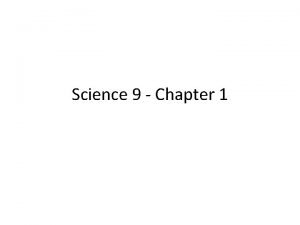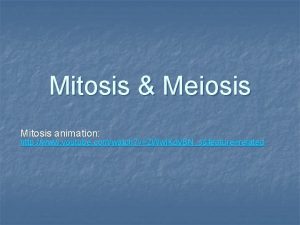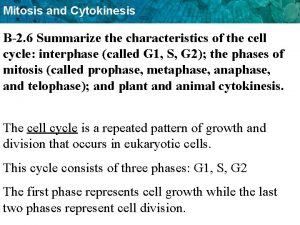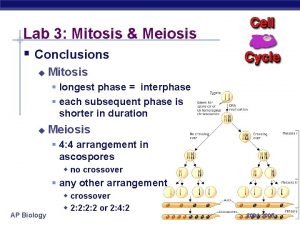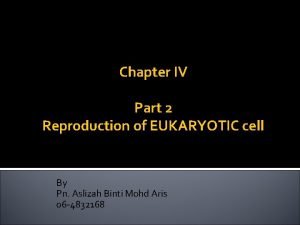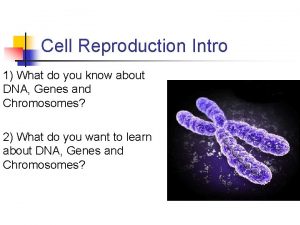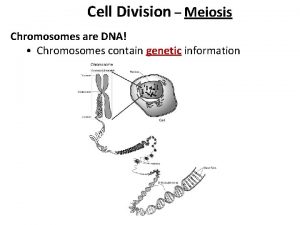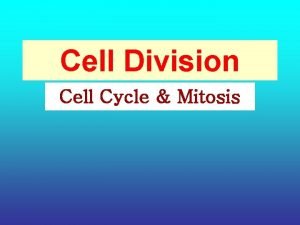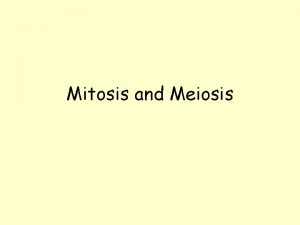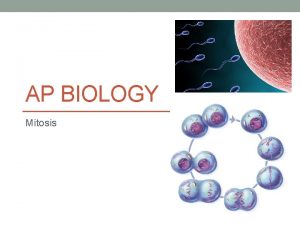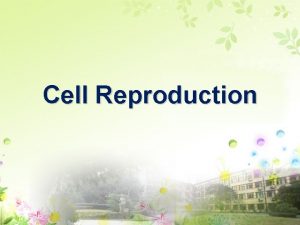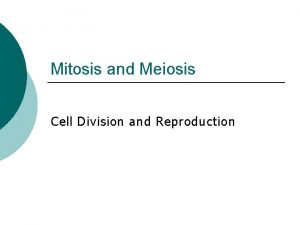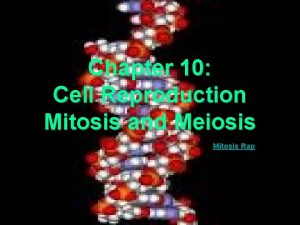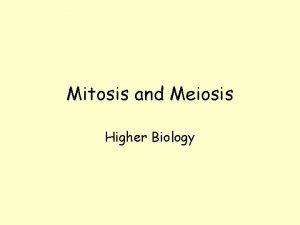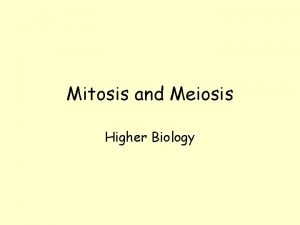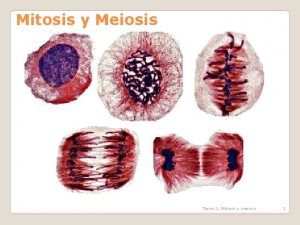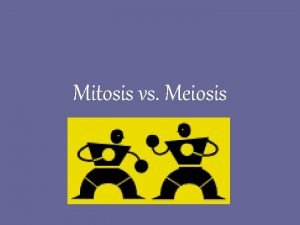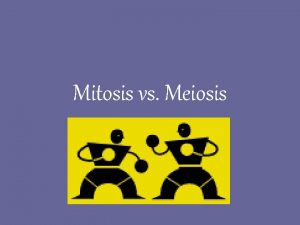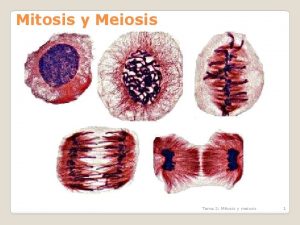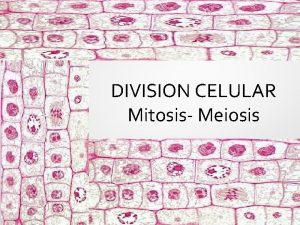Cell Reproduction Mitosis and Meiosis Cell Reproduction Most

















- Slides: 17

Cell Reproduction Mitosis and Meiosis

Cell Reproduction • Most organisms begin as only one cell • Many-celled organisms grow because cell division increases the number of cells in the organism

Mitosis • The nucleus divides to form two identical nuclei (two identical cells) • Each new cell has the same number and type of chromosomes

Interphase • Chromosomes duplicate inside the nucleus • Cells that no longer divide are always in interphase (nerve cells and muscle cells) • Actively dividing cells copy hereditary material (DNA) and prepare for cell division during interphase (skin cells)

Prophase • The chromatid pairs are formed and visible under a microscope • The nuclear membrane begins disintegrating • The centrioles move to opposite ends of the cell and spindles (thread-like fibers) begin to form

Metaphase • The chromatid pairs line up in the center of the cell • The centromere (center of the chromatid pair) attaches to a spindle fiber from each end of the cell

Anaphase • Each centromere divides, separating the chromatid pair • The spindle fibers shorten, drawing the chromosomes (half of the chromatid pair) toward opposite ends of the cell

Telophase • Spindle fibers disappear • Chromosomes start to uncoil • New nucleus forms around each set of chromosomes • Cytoplasm pinches off and separates the two cells

Asexual Reproduction • A new organism is produced from one original organism • Both organisms will have identical DNA (like a clone) • Mitosis is the process by which asexual organisms reproduce – Ex: many plants can grow asexually, like a potato sprouting buds

Regeneration • Some organisms can re-grow damaged or lost body parts by using cell division – Ex: Sea stars • If a sea star is broken into pieces, a whole new sea star will grow from each piece!

Sexual Reproduction • Two sex cells come together to form a new organism • Usually, one sex cell (sperm) comes from the male parent organism, and one cell (egg) comes from the female parent organism, both of the same species. • The result is a new organism with a unique identity (DNA)

Diploid Cells • Most of your body’s cells are diploid cells • They have pairs of similar chromosomes (23 pairs in humans) • Each chromosome has its “mate”, a chromosome that is similar in size and shape, with similar DNA

Haploid Cells • Sex cells are haploid cells • They have only one set of chromosomes (one from each pair) • So, human sperm cells and egg cells only have 23 chromosomes – When they come together, the new human cell will have a full set of 46 chromosomes (it will be diploid)

Meiosis • Process by which sex cells are made – Sperm and eggs • Meiosis occurs in two steps (two divisions of the nucleus) – Meiosis 1 – Meiosis 2

Meiosis 1 • Purpose is to split the chromatid pairs so each new cell has one chromatid from each pair • During metaphase 1, the chromosomes line up in pairs across the middle of the cell.

Meiosis 2 • Purpose is to split the chromatid pairs so each resulting cell is haploid • Each cell that undergoes meiosis results in 4 sex cells, each with half the chromosomes

Mistakes • Mistakes in meiosis are common in plants, less common in animals – If a mistake results in sex cells with too many or too few chromosomes, the offspring will either die or develop abnormally (each new cell that grows will have the wrong number of chromosomes).
 Cell division mitosis and meiosis
Cell division mitosis and meiosis Two cells are produced
Two cells are produced Concept map of mitosis
Concept map of mitosis Difference between male and female plants
Difference between male and female plants Venn diagram mitosis and meiosis
Venn diagram mitosis and meiosis Write difference between mitosis and meiosis
Write difference between mitosis and meiosis Kesler science atoms answer key
Kesler science atoms answer key How are somatic cells different from gametes
How are somatic cells different from gametes Mitosis meiosis animation
Mitosis meiosis animation Characteristics of mitosis and meiosis
Characteristics of mitosis and meiosis What is diploid and haploid
What is diploid and haploid Respirometer
Respirometer Mitosis and meiosis venn diagram
Mitosis and meiosis venn diagram Animal chromosome number
Animal chromosome number Chromosome sets (=n) in mitosis and meiosis
Chromosome sets (=n) in mitosis and meiosis Characteristics of mitosis and meiosis
Characteristics of mitosis and meiosis Crossing over meiosis
Crossing over meiosis Chromosome sets (=n) in mitosis and meiosis
Chromosome sets (=n) in mitosis and meiosis



